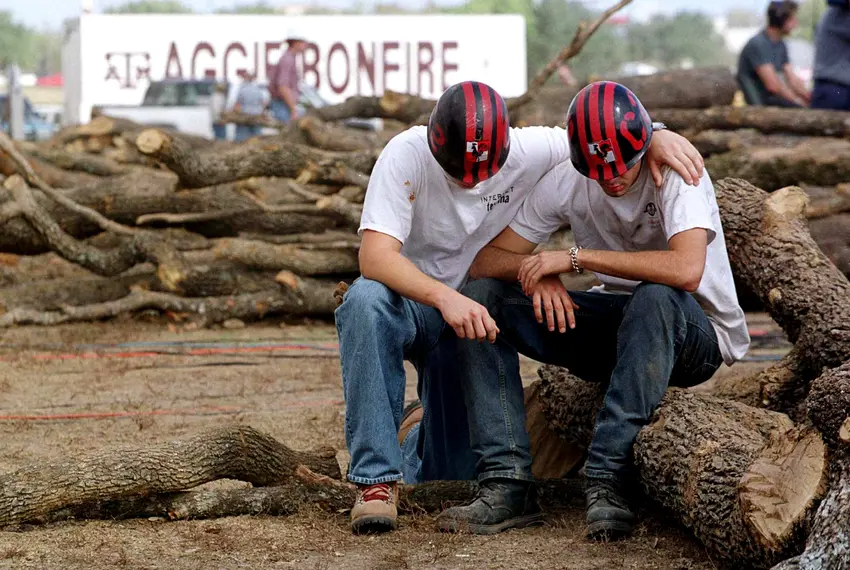
By Sneha Dey, The Texas Tribune
Building the Aggie bonfire was once among the most prized student traditions at Texas A&M University. That changed when the 60-foot stack of logs fell and killed 12 people in 1999, becoming one of the most painful chapters in the university’s history.
Now, 25 years after the tragedy, the Texas A&M University System Board of Regents is considering bringing the tradition back ahead of the school’s first football match against the University of Texas at Austin in years.
Texas A&M President Mark Welsh formed a committee in November to explore how to commemorate the renewed football rivalry with UT-Austin, as the Longhorns join the Southeastern Conference this year. In a January letter obtained by The Texas Tribune, regent and rivalry committee member John Bellinger wrote to families of the 1999 bonfire victims asking for input on the possibility of resuming the bonfire with oversight from the university’s administration.
“The members of the committee and I are extremely sensitive to your loss. I do not want to reopen the many wounds that you have but it is important to me to have your opinion,” Bellinger wrote in the letter, asking to meet with the families.
Sources close to the discussions told the Tribune that Bellinger has proposed that a construction company come in to build the bonfire. Resuming bonfires, they said, appeared to be in the interest of older alumni who had previously been involved in the tradition, rather than current students. Bellinger did not respond to a request for comment Monday.
The first bonfire in 1909 was little more than a pile of wood and trash. It, in time, grew in size and complexity, even hitting a world record in 1969. A 1947 campus handbook read: “Bonfire symbolizes two things: a burning desire to beat the team from the University of Texas, and the undying flame of love that every loyal Aggie carries in his heart for the school.”
In the early hours of Nov. 18, 1999, the stack of more than 6,000 logs that students had assembled that year toppled. Twelve people, 11 students and one former student, died and dozens more were injured, some severely. Those who survived recalled the blood, screaming and students trapped as first respondents triaged and removed the logs.
An investigation into the 1999 collapse, conducted by an independent commission at the order of the Texas A&M administration, found flawed construction led by unqualified student workers caused the wreckage. The report described “excessive internal stresses” on the logs and “inadequate containment strength” in the wiring tying the logs together. It also described “an environment in which a complex and dangerous structure was allowed to be built without adequate physical or engineering controls.”
When Texas A&M settled lawsuits with victims of families in the aftermath, the university committed to providing architectural and engineering oversight by professionals if it ever brought the tradition back, Darrell Keith, a Fort Worth attorney who represented the plaintiffs, told the Fort Worth Star-Telegram in 2014.
A small group of students now builds an unsanctioned bonfire every fall, about 15 miles away from campus. Bellinger cited safety concerns about those bonfires in his letter to the families of the victims.
“This bonfire has minimal oversight of safety measures and there is a concern that even though this is not a university-sanctioned event, it still involves several hundred TAMU students who could potentially be at risk,” said Bellinger, identifying himself in the letter as a father to a son who once helped build the off-campus bonfire.
Bellinger argued that university oversight of the tradition was in the interest of mitigating those risks. But another rivalry committee member told the Tribune there has been a clear understanding at meetings that students would likely continue to build off-campus bonfires even if Texas A&M started to organize official ones.
The committee member, who spoke on the condition of anonymity in fear of retaliation, said the two regents that sat on the rivalry committee appeared to have “an agenda.”
Bellinger reached out to the families of all 12 people who died in the 1999 disaster. As of January, Bellinger had visited with six of the families, three of which gave him the OK to restart the tradition, according to committee meeting notes.
“He strongly implied, if not said, that the families who didn’t agree with bringing back bonfire… they didn’t understand the spirit of the tradition and what it means to Aggies,” the committee member said. “It felt like it was just a box to check in saying that, ‘hey, we tried,’ before creating this tradition that he [Bellinger] wants to bring back.”
Welsh is scheduled to get recommendations from the rivalry committee in May. Susan Ballabina, the president’s chief of staff, said no decisions have been made yet about whether the bonfire will resume.
“After the president is briefed [about the recommendations], he will share his decisions on ideas that will be implemented,” Ballabina said in a statement.
The Texas Tribune partners with Open Campus on higher education coverage.
Disclosure: Texas A&M University, Texas A&M University System and University of Texas at Austin have been financial supporters of The Texas Tribune, a nonprofit, nonpartisan news organization that is funded in part by donations from members, foundations and corporate sponsors. Financial supporters play no role in the Tribune’s journalism. Find a complete list of them here.
This article originally appeared in The Texas Tribune at https://www.texastribune.org/2024/04/09/texas-am-bonfire-tradition/.
The Texas Tribune is a member-supported, nonpartisan newsroom informing and engaging Texans on state politics and policy. Learn more at texastribune.org.



